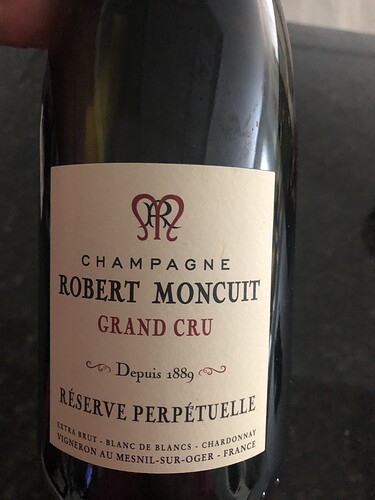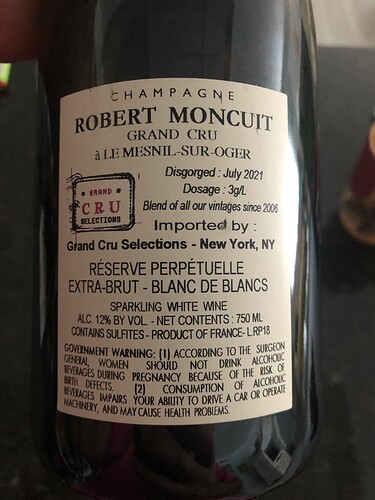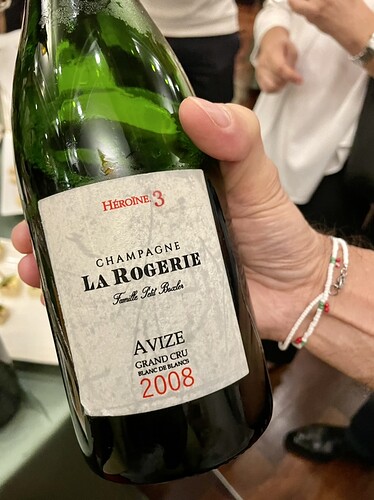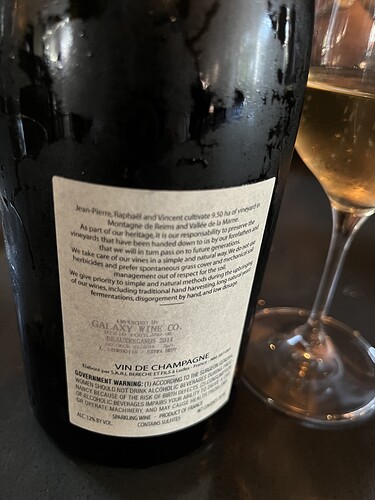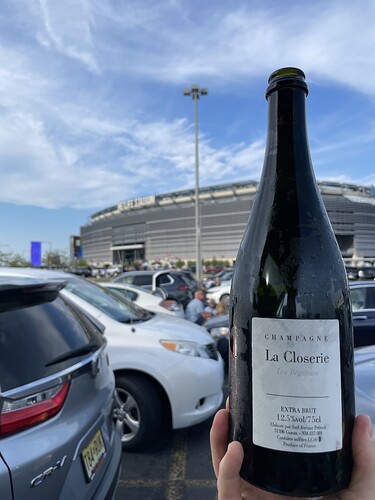Nice wine for the price. Has that golden Chardonnay color to it. Not much in the way of bubbles, very fine. Showing pear and quince on the palate. I didn’t get any oxidative notes with it as others have mentioned. Finish showed lime notes to me and a bit of a bitterness tonit at the end. Disgorged July 2021. Dosage 3g. 12%
I think the fun thing about wine is that preferences affect enjoyment. I can think of a lot of pinot noir and chardonnay that can be 95 pts with full body, or medium body. I’ve even had some ethereal, intensely aromatic, and delightfully haunting lighter bodied pinots and chards. I really see no reason why champagne can’t also slot similarly, especially given the wide variation of styles and production methods used to make it, and that’s even aside from what it’s made from.
In a similar celebratory vein, I opened a 2009 Dom Ruinart BdB to celebrate my first hole in one, which came Saturday in a round I played with my dad. A joyous occasion in what was otherwise the worst round of golf I’d played in a decade. Ahhhh balance.
2009 Dom Ruinart BdB - 10 years on lees, 4g/l. This is a creamy, vanilla and floral scented wine with lovely undercurrents of pear, white peach, and cream puff. Silky smooth and easy to drink. It’s delicious, orchard driven, with a smooth vanilla cream finish. A good, not great, Dom BdB. 94ish.
From a champagne event a couple of weeks ago that my wife helped organise, these two (along with the 2004 Pommery Cuvée Louise) stood out:
Belated happy anniversary to you two!
One of our friends Ann in Bham has been telling us about L’Abattoir. Did you do the Chef’s tasting menu?
This is from a dinner a few weeks ago, Bereche Les Beaux Regards. Older vines blanc de blanc from the Ludes. This bottle was from 2014. It seemed pretty tight, only showing yeasty aromatics at first. Some citrus and apple but only after it was open a while. Complex and long but really only hinting at what it could be. Recommend waiting, should be great in a few years.
Yes. Every dish was outstanding. We didn’t do the wine pairing.
very intense. Very vinous. Creamy with old vine density in the fruit. Mostly chardonnay. Finished very long. Merci, Mssr. Pennet.
Thank you for the notes! I have a 2010 in the cellar…
Solessence Nature Elevage Prolongé
50% Chardonnay, 40% Meunier, and 10% Pinot Noir with 50% perpetual reserve wine. Disgorgement in October 2022. Zero Dosage.
This bottle reminds me that I should drink more Séleque. I’m uncertain about the vintage but it has a warm vintage character. Golden color, mild effervescence, less tension, more wine-like. A rich, expansive champagne style with aromas of ripe quince, ginger ale, and embryonic autolytic nuances. Robust salty minerality and a powerful finish. At present, it needs a lot of aeration; it is a 100% gourmand champagne, which, in my opinion, pairs best with richer dishes. It would complement foie gras or lobster well. 95 points, and this champagne will undoubtedly benefit from some ageing. A champagne at the level of Egly-Ouriet ‘Tradition’ Grand Cru Brut without the price tag.
95 points huh? Here we go again…
Aside: Not always easy to find a broad selection of champagne in Dallas, but my local shop typically carries a few Seleque offerings, which I tend to snap up when I see them. Good producer, nice range of offerings, nice pricing for now.
Aha, so its not that WK gives too high scores - its that he gives them to the wrong wines? =)
This one I believe he gave a 92 - compared to your 95…
To be fair, who is more likely to move market prices? DP? Or WK? I think that’s a key element in Donald’s scoring posts above.
If you cannot beat them, jointhem.
It’s kind of interesting that the 100-point scale is in actuality more like a 13-14 point scale, since I almost never see anything rated below 87 (and anything that would fall in between 0-87 would probably be considered cataclysmically bad).
I suppose it depends on how many bottles Donald has for sale.
In my limited circle, Seleque’s champagnes are selling. It’s clear we need to implement a point system to condition customers for the looming dilemma. Egly plans their release after harvest, yet last year William Kelley, deliberately or not, revealed the scores beforehand. This act led to a significant price adjustment by the winery. How can we move these overpriced bottles if Kelley doesn’t soon release his scores? Are we left to fabricate our own?
Sadly unlike you, Greg, not everyone’s palate is a slave to price tags instead of the actual merits of the bottle.
If you thought they were overpriced and difficult to move, why did you take them then? Seems like bad business =)
Grower champagne has taught me a few things. First, the disparity in quality between producers isn’t as stark as in Burgundy. Quantity, brand perception, and scores often outweigh what many wine drinkers would admit.
Never relinquish an allocation. Second, to sell lesser-known producers, stock the big names to establish credibility, encouraging buyers to explore better-value or unknown options.
.Third, higher margins from well-known brands can subsidize lesser-known ones, particularly important when lacking critic support. Take Laherte Freres and JM Seleque as examples; both are gaining price traction, especially the former. Then there’s Tellier, same area—lesser-known and improving. Their champagnes aren’t at the same level but the quality gap is narrowing and this is reflected in the price. We opt for slimmer margins with Tellier, subsidized by established brands like Laherte or Seleque, essentially having customers pay for the label.
